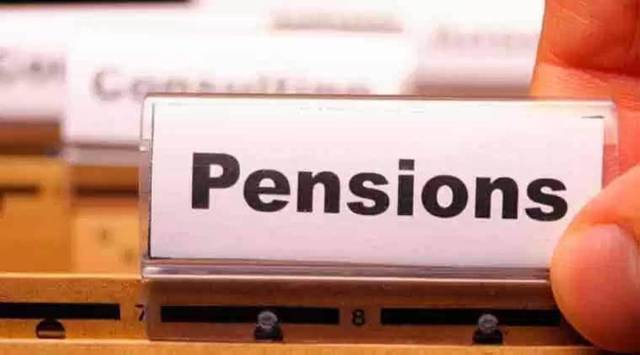
In a recent proposal presented to the committee led by the Finance Secretary, which was established to assess the New Pension System (NPS) for government employees, certain states have put forth a compromise solution. This solution involves a reduced pension amount but with the assurance of payment.
Specifically, some states are advocating for a guaranteed pension tied to the minimum pay level, rather than basing it on the final salary drawn, as is the case in the Old Pension Scheme (OPS). One of the emerging proposals addresses the concern that the minimum pension need not necessarily be 50 percent of the last salary received but should be set at a certain level, equivalent to 50 percent of the lowest entry-level pay in the pay matrix. An informed source commented on this development, saying, "This is one of the demands being raised."
Under the Seventh Pay Commission, the prior system of pay bands and grade pay was replaced by a pay matrix. An employee's status within the pay matrix determines their level. The 7th Pay Matrix comprises 760 cells, divided into 19 columns and 40 rows, signifying different pay levels for various job roles and the salary progression an employee can expect throughout their career.
To date, several states, including Rajasthan, Chhattisgarh, Jharkhand, Punjab, and Himachal Pradesh, have reverted to the Old Pension Scheme (OPS) from the NPS. In March, even the BJP-Sena (Shinde faction) government in Maharashtra gave in-principle approval to extend OPS's financial benefits to NPS members. The state government is likely to increase its contribution to pensions from the current 14 percent to 20 percent of basic salary plus dearness allowance.
Currently, the government contributes 14 percent to NPS, while employees contribute 10 percent of their salary plus dearness allowance.
Under OPS, government employees receive predetermined benefits after retirement, with a monthly pension equivalent to 50 percent of their final salary. In contrast, the NPS, which covers employees who joined service after January 2004, has defined contributions, but the benefits are subject to market performance.
In March of this year, the Central government informed Parliament that it was not considering any proposal to reinstate OPS for its employees recruited after January 1, 2004. However, the government did allow certain government employees, whose positions were advertised before the NPS notification in December 2003, a one-time option to switch to OPS.
With concerns raised by government employee unions about the NPS and its returns, Union Finance Minister Nirmala Sitharaman announced the formation of a panel to review the pension system for government employees. Subsequently, a four-member committee led by Finance Secretary T.V. Somanathan was established in April. According to its terms of reference, the committee will evaluate whether any changes are necessary within the existing NPS framework for government employees and recommend improvements to pension benefits while ensuring fiscal responsibility to protect the interests of the general public.

 🕑 28 Oct, 2025 04:46 PM
🕑 28 Oct, 2025 04:46 PM
8th Pay Commission constituted. ToR Approved, Effectively Jan 2026
 🕑 02 Jul, 2025 10:03 AM
🕑 02 Jul, 2025 10:03 AM
Commutation Relief In Sight? Panel Likely To Review 15-Year Deduction Rule
 🕑 12 Jun, 2025 08:12 AM
🕑 12 Jun, 2025 08:12 AM
8th Pay Commission: Uncertainty Looms as Employees Await Terms of Reference
 🕑 24 Apr, 2025 10:21 PM
🕑 24 Apr, 2025 10:21 PM
Staff Side constitutes panel for drafting memorandum to 8th CPC when formed
 🕑 24 Apr, 2025 10:17 PM
🕑 24 Apr, 2025 10:17 PM
8th Pay Commission likely to be set up by mid May
 🕑 09 Apr, 2025 10:27 AM
🕑 09 Apr, 2025 10:27 AM
Loan EMIs to get Cheaper as RBI cuts Repo Rate sgain | See the benefit
 🕑 09 Jun, 2025 08:25 AM
🕑 09 Jun, 2025 08:25 AM
📢 UPS vs NPS: The Retirement Dilemma Facing 27 Lakh Government Employees
 🕑 04 Apr, 2025 04:46 PM
🕑 04 Apr, 2025 04:46 PM
NPS To UPS Switch from April 1: A Detailed Look at the Option to Switch
 🕑 30 Mar, 2025 11:01 AM
🕑 30 Mar, 2025 11:01 AM
8th Pay Commission implementation may get delayed till 2027 – Here’s why
 🕑 27 Mar, 2025 10:25 PM
🕑 27 Mar, 2025 10:25 PM
7th CPC wanted a permanent pay panel, end DA revision twice
 🕑 27 Mar, 2025 08:43 AM
🕑 27 Mar, 2025 08:43 AM
8th Pay Commission: What Kind Of Salary Hike Can Be Staff Expected?
 🕑 20 Mar, 2025 08:24 AM
🕑 20 Mar, 2025 08:24 AM
Why the commuted pension is restored after 15 years, not 12 years
 🕑 17 Mar, 2025 08:37 AM
🕑 17 Mar, 2025 08:37 AM
📈 Expected Dearness Allowance (DA) from January 2026 Calculator